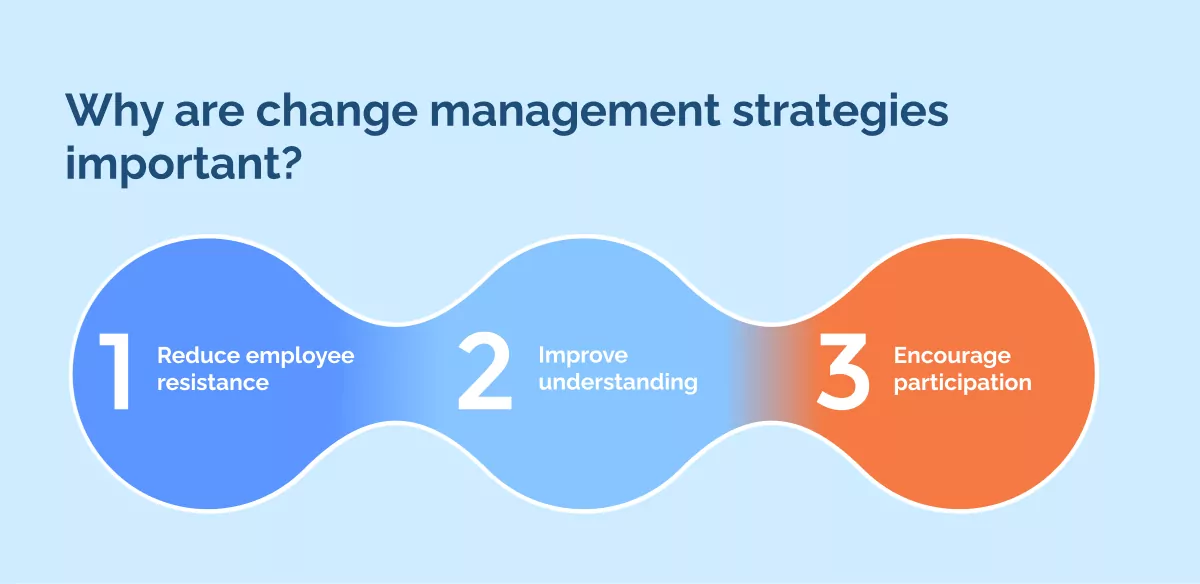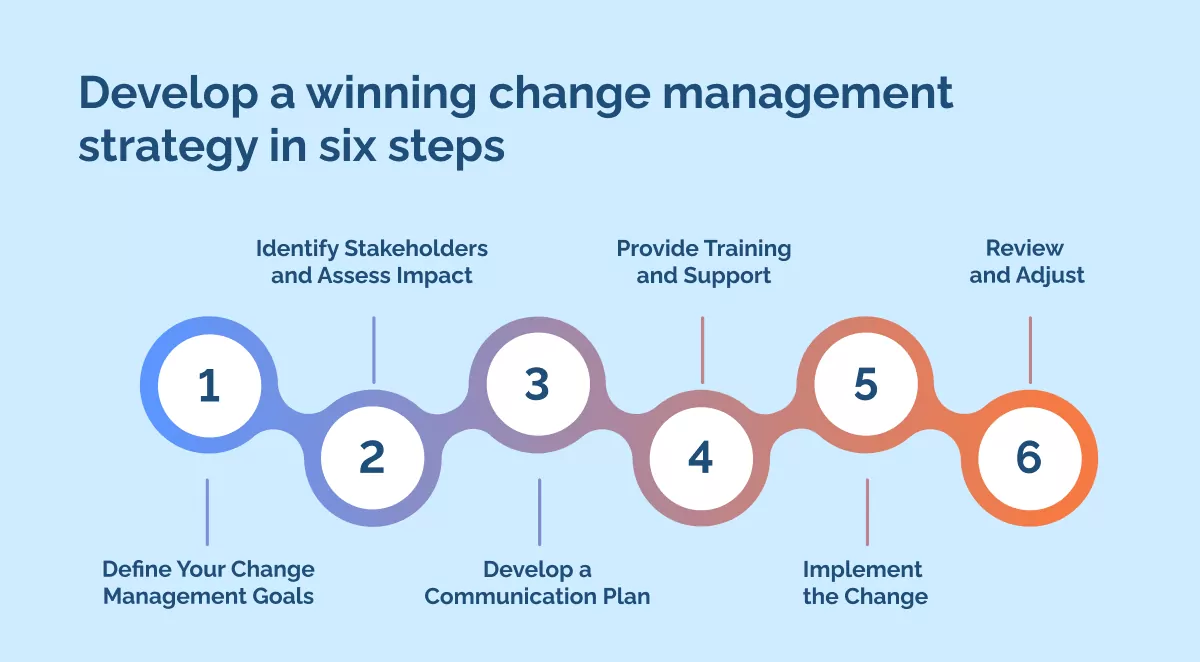
Just 34% of change initiatives manage to achieve success. This shocking figure highlights the importance of having in-depth knowledge and skills to successfully navigate digital transformation initiatives.
However, all is not lost. Studies have shown that organizations that wholeheartedly implement change management are 47% more likely to successfully achieve their objectives than those that disregard it.
It involves managing the transition from the current state to a desired future state, mitigating resistance, and ensuring the changes are sustainable over time.
In an era where technological advances and market shifts can turn industries upside down overnight, the ability to adapt and evolve is more vital than ever. However, implementing change isn’t as simple as flipping a switch. It requires careful planning, clear communication, and thoughtful execution to minimize disruption and maximize benefits.
A well-crafted change management strategy outlines the steps necessary to implement change and considers the human elements involved. It acknowledges the emotions, fears, and resistance often accompanying significant changes and provides strategies to address these issues head-on.
Whether your organization is implementing new technology, restructuring departments, or undergoing a complete cultural transformation, this guide will provide you with the tools and strategies needed to navigate the change successfully. We will delve into the key elements of a successful change management strategy, including stakeholder analysis, communication planning, training, and support structures.
Join us as we explore the ins and outs of developing a change management strategy that not only helps your organization reach its goals and empowers your team to thrive amidst change.
What is change management?
Change management is a systematic approach to dealing with the transition or transformation of an organization’s goals, processes, or technologies.
It involves methods that redirect or redefine the use of resources, business processes, budget allocations, or other modes of operation to achieve significant change.
What is a change management strategy?
A change management strategy is a systematic approach to dealing with the transition or digital transformation of an organization’s goals, processes, or technologies. It ensures that changes are implemented smoothly and successfully to achieve lasting benefits.
Change management strategies involve understanding the changes needed, planning for implementation, managing the transition, and ensuring the changes are effectively communicated, understood, and adopted within the organization.
It’s designed to minimize resistance, increase engagement, improve performance, and ensure the organization’s overall readiness for change.
Why are change management strategies important?
Change management strategies are integral to the success of any organization in today’s fast-paced and ever-evolving business environment. They help organizations adapt to changes, drive business growth, and improve organizational effectiveness.
One of the primary reasons why change management strategies are crucial is because they help manage resistance to change. People are naturally inclined to resist change, especially if they perceive it as a threat to their job security or comfort zone.
Well-crafted change management strategies can:
- Reduce employee resistance: They provide a clear plan for managing and communicating change, thereby reducing employee anxiety and resistance.
- Improve understanding: They ensure everyone understands why the change is necessary, what it entails, and how it will benefit them and the organization.
- Encourage participation: They involve employees in the change process, making them feel valued and encouraging their buy-in and support.
Change management strategies also play a critical role in ensuring business continuity during periods of change. Organizations can minimize disruptions to their operations and maintain productivity by developing a detailed plan for managing change.
These strategies can:
- Prioritize changes: They help organizations prioritize changes based on their impact and urgency, ensuring that the most important changes are implemented first.
- Manage the risks: They identify potential risks associated with the change and develop strategies to mitigate them.
- Measure progress: They establish metrics for measuring the progress and success of the change initiative, enabling organizations to make necessary adjustments along the way.
Develop a winning change management strategy in six steps
Navigating the dynamic business world demands a robust change management strategy.
Let’s delve into crafting a blueprint that fosters resilience, encourages adaptability, and drives your organization confidently into the future.
Step 1: Define Your Change Management Goals
Defining your goals is the first step in developing a successful change management strategy. This involves understanding what you want to achieve with the change and how it aligns with your organization’s overall objectives.
Think about the specific outcomes you want to see, whether they’re related to improving efficiency, enhancing customer service, or increasing profitability. It’s also crucial to consider the impact of the change on different stakeholders, including employees, customers, and shareholders.
A clear understanding of your goals will guide the rest of your change management strategy and help you measure its success.
TLDR:
- Understanding the Goals: Before initiating any change, you must understand what you aim to achieve with this transition. This could be anything from increasing operational efficiency, enhancing customer service, or boosting revenue.
- Alignment with Organizational Objectives: The change must align with your organization’s overall objectives. This alignment ensures that all efforts are directed towards achieving common goals, promoting unity and coherence within the organization.
- Impact on Stakeholders: Consider the effect of the change on various stakeholders like employees, customers, and shareholders. It helps in anticipating potential challenges and planning strategies to mitigate them.
Step 2: Identify Stakeholders and Assess Impact
Next, identify who will be affected by the change and to what extent. This could range from top-level management to frontline employees and even customers. Understanding the stakeholders’ roles and how they’ll be impacted can help you anticipate resistance and plan strategies to overcome it.
Also, consider potential risks that might arise from the change and how to mitigate them. This stage often involves conducting a SWOT analysis (Strengths, Weaknesses, Opportunities, Threats) to understand the full impact of the change.
TLDR:
- Identifying Stakeholders: Recognize all individuals or groups affected by the change. It may include everyone from top-level management to frontline employees and customers. Understanding their roles can help predict potential resistance and plan appropriate strategies.
- Assessing Impact: Evaluate how the change will impact each stakeholder. This assessment can help better communicate about the change and manage expectations effectively.
- Risk Mitigation: Anticipate possible risks associated with the change and devise strategies to mitigate them. This might involve conducting a SWOT analysis to understand the full impact of the change.
Step 3: Develop a Communication Plan
Communication is key in any change management strategy. After identifying your stakeholders, you must develop a plan to keep them informed throughout the process. This includes explaining why the change is necessary, the expected benefits, and how it will affect them.
The communication plan should also outline when and how information will be shared, ensuring everyone stays updated. Remember, transparent and timely communication can significantly reduce resistance and foster a culture of acceptance.
TLDR:
- Explaining the Change: A successful change management strategy includes clear communication about why the change is necessary, its expected benefits, and its impact on stakeholders.
- Communication Strategy: Develop a plan specifying when and how information will be shared to keep everyone updated. Regular updates can minimize resistance and promote acceptance of the change.
- Transparent Communication: Transparency in communication can help build trust among stakeholders and ensure their cooperation during the transition.
Step 4: Provide Training and Support
Change often requires people to learn new skills or adapt to new processes. As such, providing appropriate training and support is critical. This could involve workshops, seminars, or one-on-one coaching sessions, depending on the nature of the change.
The aim is to empower your team with the knowledge and skills necessary to navigate the change triumphantly. Extending emotional support can alleviate fears and anxieties associated with the change, fostering a seamless and effortless transition.
TLDR:
- Skill Development: Changes often require stakeholders to acquire new skills or adapt to new processes. Providing necessary training through workshops, seminars, or coaching sessions can help ease this transition.
- Support: Alongside training, emotional support to stakeholders can alleviate fears and anxieties about the change, leading to a smoother transition.
- Empowerment: The ultimate goal is to equip your team with the knowledge and skills to embrace the change successfully.
Step 5: Implement the Change
Now it’s time to put your plan into action. Implement the change according to your predetermined timeline and milestones, making sure to monitor progress and address any issues that arise promptly.
Be prepared for resistance and unexpected challenges, but remember these are normal parts of any change process. Keep the lines of communication open and provide support as needed to ensure a successful implementation.
TLDR:
- Action Plan: After thorough planning, it’s time to implement the change according to the predetermined timeline and milestones. Regular monitoring of progress can help in promptly addressing any issues that arise.
- Dealing with Resistance: Resistance and unexpected challenges are part of any change process. Keeping communication lines open and providing as-needed support can help overcome these hurdles.
- Monitoring Progress: Regular progress checks can ensure that the implementation is on track and is moving towards achieving the desired goals.
Step 6: Review and Adjust
After the change has been implemented, take the time to review its effectiveness against your original goals. Did you achieve what you set out to do? What worked well, and what didn’t?
Use this feedback to make any necessary adjustments, whether that means tweaking certain aspects of the change or providing additional training and support. Remember, change management is an ongoing process, not a one-time event. Regular reviews and adjustments will help you stay agile and responsive to your organization’s evolving needs.
TLDR:
- Review: Once the change is implemented, review its effectiveness against the original goals. Reflect on what worked well and what didn’t to learn for future change initiatives.
- Adjustments: Based on feedback, make necessary adjustments. This could mean changing existing processes or providing additional training and support.
- Continuous Improvement: Remember that change management is an ongoing process, not a one-time event. Regular reviews and adjustments can help keep up with the organization’s evolving needs.
How To Effectively Measure Your Change Management Strategy
Change management measurements are typically surveys, assessments, tests, and observations of the change activities and business outcomes. So organizations use both qualitative ad quantitative metrics to determine a successful change management strategy.
Quantitative Measurements Include:
Time taken to adopt the changes: This metric measures the duration between introducing a change and when most employees have successfully implemented it in their daily operations. It can be indicative of the effectiveness of change management and training processes.
Number of people who have adopted the changes successfully: This measures how many employees have fully embraced the new changes. It can provide insights into the effectiveness of the change implementation strategy.
ROI and benefit realization: This measures the return on investment for the changes implemented. It’s calculated by comparing the benefits realized (like increased productivity or cost savings) against the costs involved in implementing the change.
Adherence to the project timeline: This metric tracks whether the change implementation is on schedule. Delays can increase costs and negatively impact the overall project.
Employee engagement: This metric gauges employees’ involvement and enthusiasm with their work and the workplace. High engagement can indicate a positive response to the changes.
Support requests: The number of support requests can indicate how well employees understand the new changes. A high number of requests might suggest that additional training or resources are needed.
Error logs: These are records of the errors that occur during the operation of a system. An increase in errors might suggest problems with the implemented changes.
Training attendance numbers and participation: These metrics measure how many employees attend training sessions and how actively they participate. High attendance and participation rates suggest a positive reception to the changes.
Project KPIs: Key performance indicators (KPIs) are specific, measurable outcomes that indicate the success of a project. For a change implementation project, KPIs include metrics like reduced operational costs or increased customer satisfaction.
User login volume: This measures the number of times users log into a system. An increase in login volume might indicate the successful adoption of a new system or process.
Audit and compliance findings: These findings can reveal if the changes comply with relevant regulations and standards, which is crucial for legal and operational reasons.
Transaction volume: This refers to the number of transactions processed within a given timeframe. An increase in transaction volume can suggest the successful adoption of a new system or process.
Qualitative Measurements Include:
Employee Satisfaction Survey Results: This metric gauges employees’ overall happiness and contentment in their work environment. As per recent survey results from CNN Business, just over 62% of US employees indicated overall job satisfaction, a 2.1 percentage point increase from the previous year. The survey evaluated employee satisfaction in areas like job satisfaction, communication/priorities, supervision/involvement, etc.
Employee Readiness Assessment Results: This metric evaluates how prepared employees are for organizational changes or new initiatives. It can include assessments of skills, knowledge, attitudes, and behaviors necessary for the transition. While I couldn’t find specific numbers, these assessments are crucial for successful change management.
Communication Effectiveness: This metric measures how well information is transmitted and received within the organization. It can be evaluated through feedback surveys or by assessing the outcomes of specific communication strategies. Effective communication is key to employee satisfaction and operational efficiency.
Training Effectiveness: This metric assesses how well training programs are working. It can be measured by analyzing skill acquisition, changes in performance, and employee feedback post-training. Effective training can lead to increased job satisfaction and improved performance.
Employee Feedback: This metric assesses employees’ opinions and perceptions about their work environment, management, and other work-related issues. It’s often collected through surveys, interviews, or suggestion boxes. Recent surveys indicate that 71% of employees are satisfied, suggesting employers take employee feedback seriously and make necessary improvements.
Quality of Work After Implementing Changes: This metric gauges the impact of organizational changes on the quality of work. It can be measured by comparing pre-change and post-change performance indicators. Improvement in this area indicates successful implementation of changes and positive acceptance by employees.
Now you have a winning change management strategy. What next?
After successfully developing a change management strategy, an organization enters the critical phase of monitoring and adjusting the strategy to ensure it achieves its desired outcomes.
- Monitoring: After the implementation, ongoing monitoring is essential to measure the strategy’s effectiveness. Regular check-ins, surveys, and feedback sessions can gauge how well the changes are being received and whether they lead to the desired improvements. Key performance indicators (KPIs) should be established before implementation to quantify and track progress.
- Adjustment: No strategy is perfect from the start, and some adjustments will likely need to be made based on the feedback and data collected during the monitoring stage. This could involve tweaking certain aspects of the strategy, providing additional resources, or even reverting some changes if they are not having the expected impact.
- Consolidating the Change: Once the changes have been fine-tuned and are producing the desired results, efforts should be made to consolidate and institutionalize these changes within the organization. This could involve updating company policies, procedures, or structures to reflect the new ways of doing things.
- Review and Continuous Improvement: Even after the change has been consolidated, it’s important to continually review the strategy and its outcomes. The business environment is constantly evolving, and organizations must adapt accordingly. Regular reviews allow for continuous improvement and ensure the organization remains agile and responsive to new challenges and opportunities.
Remember, change is not a one-time event but a continuous process. A well-implemented change management strategy can enable an organization to navigate through uncertainties and emerge stronger and more resilient.
WalkMe Team
WalkMe spearheaded the Digital Adoption Platform (DAP) for associations to use the maximum capacity of their advanced resources. Utilizing man-made consciousness, AI, and context-oriented direction, WalkMe adds a powerful UI layer to raise the computerized proficiency, everything being equal.









